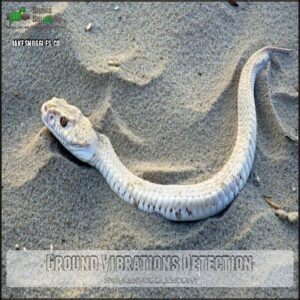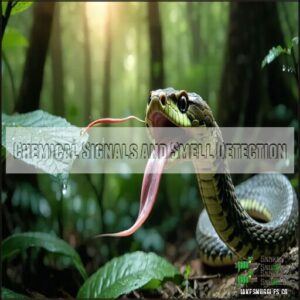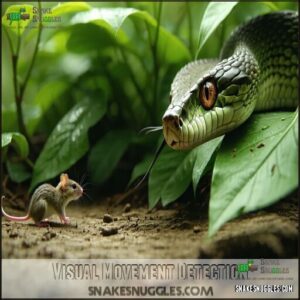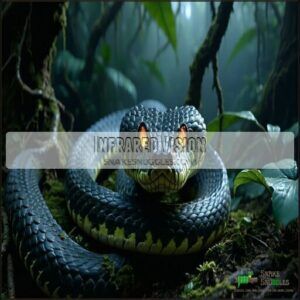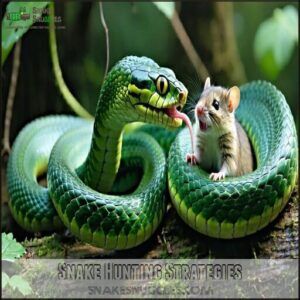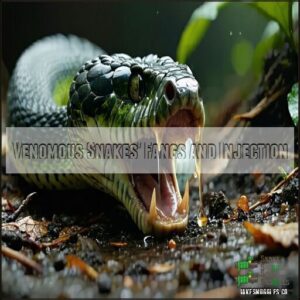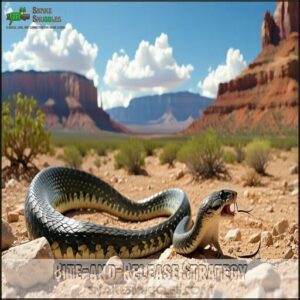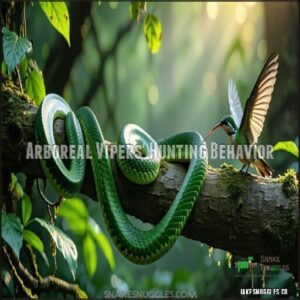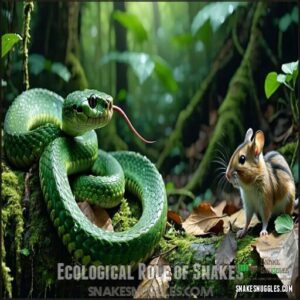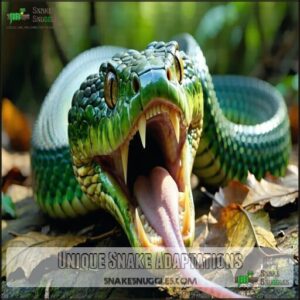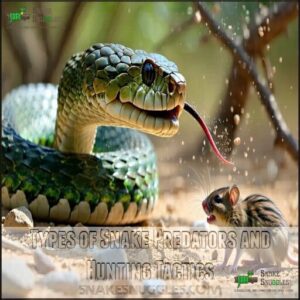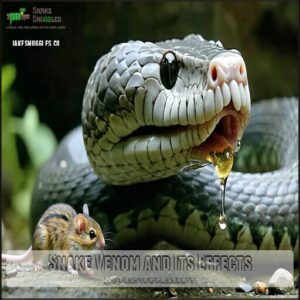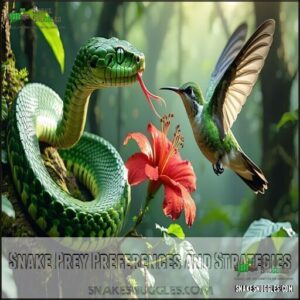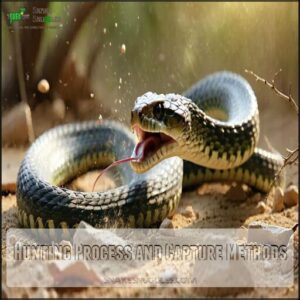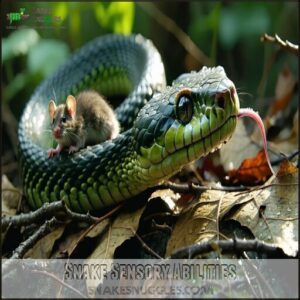This site is supported by our readers. We may earn a commission, at no cost to you, if you purchase through links.
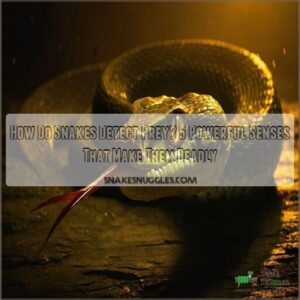
They "hear" vibrations through their jawbones, sensing movement nearby. With their forked tongues, they sample air particles, basically “smelling” the location of prey.
Some species, like pit vipers, use heat-sensing pits to detect infrared radiation—imagine seeing a warm, glowing outline in total darkness. Their keen eyes spot motion, though most snakes rely more on heat and scent.
Think of it as having a superpower toolbox made for survival. Each sense works together, making snakes deadly efficient predators.
Curious how these adaptations shape their hunting tactics? Keep reading!
Table Of Contents
- How Do Snakes Detect Prey?
- Snake Sensory Adaptations
- Snake Hunting Strategies
- Snake Predation Techniques
- Ecological Role of Snakes
- Unique Snake Adaptations
- Types of Snake Predators and Hunting Tactics
- Snake Venom and Its Effects
- Snake Prey Preferences and Strategies
- Hunting Process and Capture Methods
- Snake Sensory Abilities
- Frequently Asked Questions (FAQs)
- Conclusion
How Do Snakes Detect Prey?
Through a remarkable arsenal of sensory adaptations, snakes detect prey with precision that would make any predator envious.
Their specialized sensory organs work in concert, creating an integrated prey tracking system. When a mouse scurries nearby, the snake’s belly detects ground vibrations, while heat sensing pits identify the warm-blooded target’s location.
Their forked tongue, constantly flicking, samples chemical signals in the air, building a 3D scent map. Some species employ infrared detection to "see" heat signatures even in complete darkness.
Despite their reputation for poor eyesight, many snakes have exceptional motion detection. Their hunting tactics often involve patient waiting—snake camouflage making them virtually invisible until it’s too late.
Snakes utilize thermal sensing abilities to pinpoint the location of warm-blooded prey with great accuracy.
Snake Sensory Adaptations
You’ll find that snakes utilize a sophisticated array of sensory adaptations including thermal detection, chemical analysis, and vibration sensing to locate and track prey with remarkable precision.
These specialized systems work together, allowing snakes to create a multidimensional awareness of their environment even in complete darkness or when hunting concealed prey, which is a result of their ability to use sophisticated sensory adaptations.
Ground Vibrations Detection
Snakes possess remarkable vibration sensors that detect subtle ground waves created by moving prey.
Their jawbones function as specialized seismic detectors, converting vibrations into neural signals with incredible precision.
This vibration sensitivity varies by substrate—sand transmits waves differently than soil or rock.
You’ll find this seismic sense particularly developed in burrowing species, which rely heavily on ground vibrations to locate prey even when visual cues are absent.
Snakes also utilize snake sensory adaptations to detect and capture their prey effectively, using their unique abilities to thrive in their environment with incredible precision.
Heat Pit Thermal Sensing
Some pit vipers, pythons, and boas possess remarkable heat-sensing pits between their eyes and nostrils that function like sophisticated infrared cameras.
These specialized pit organs detect tiny temperature differences of just 0.003°C, allowing precise prey location even in complete darkness.
- Pit organs work like miniature pinhole cameras capturing infrared radiation
- Thousands of thermo-receptive cells fill these specialized structures
- TRPA1 channels open when detecting even minute temperature increases
- Heat signatures create a three-dimensional thermal map in the snake’s brain
- This system operates independently from the snake’s visual system
The extraordinary thermal imaging capabilities provide these predators with a significant hunting advantage, letting them detect warm-blooded prey up to one meter away through the thermal sense alone.
Unlike technological infrared sensors, these natural heat pits have evolved over millions of years into remarkably efficient detection systems.
The snakes’ ability to detect heat is based on infrared radiation detection mechanisms that allow them to locate prey effectively.
Chemical Signals and Smell Detection
While heat-sensing pits provide thermal detection, a snake’s chemical sensing system offers another hunting advantage.
Their forked tongues collect scent particles, transferring them to the Jacobson’s organ (vomeronasal organ) in the roof of their mouth.
This specialized olfactory system analyzes chemical cues with remarkable precision, allowing snakes to track prey trails, determine direction, and even assess potential meal size—all without traditional nostrils or smell receptors, utilizing their unique ability to detect and process chemical signals through the vomeronasal organ.
Visual Movement Detection
While chemical signals provide one hunting advantage, a snake’s optical sensing abilities shouldn’t be underestimated.
You might be surprised by their visual movement detection capabilities:
- Their specialized eye structure excels at motion tracking, instantly spotting the slightest prey movements
- Visual acuity focuses primarily on detecting movement cues rather than static objects
- Snake vision compensates for limited distance perception through exceptional movement sensitivity
This remarkable visual system works alongside their other senses for deadly precision.
Infrared Vision
While some snakes rely on movement detection, others have developed a remarkable superpower: infrared vision.
Through specialized heat-sensing pits located between their eyes and nostrils, pit vipers, pythons, and boas can detect thermal radiation emitted by warm-blooded prey.
These pit organs basically function as thermal imaging devices, allowing snakes to "see" heat signatures even in complete darkness – transforming them into deadly nighttime hunters.
Snake Hunting Strategies
You’ll discover that snakes employ diverse predatory techniques ranging from venom injection to powerful constriction methods based on their physiological adaptations.
These hunting strategies, which include both active pursuit and patient ambush tactics, allow snakes to effectively capture prey across varied ecological niches, utilizing diverse predatory techniques.
Venom Use for Immobilization
While some snakes rely on their sensory adaptations to locate prey, venomous species take hunting a step further with biochemical warfare.
Venomous snakes inject toxic cocktails through specialized fangs directly into their prey’s bloodstream.
These potent toxin mixtures contain neurotoxins that rapidly attack the nervous system, causing paralysis.
The venom delivery system is remarkably efficient, allowing snakes to immobilize prey without struggle, reducing injury risk while they wait for their dinner to succumb.
Constriction for Prey Subjugation
When constrictors hunt, they employ remarkable constriction methods for prey subjugation.
These powerful predators use axial myology to manipulate their ribs, creating a fatal embrace around their victim.
As prey exhales, constrictors tighten their coils, preventing inhalation and ultimately causing death.
This precise constriction technique cuts off blood circulation to essential organs rather than simply suffocating prey, making it an incredibly efficient hunting strategy.
Combining Venom and Constriction
While constrictors rely on squeezing power, some snake species employ a deadly combination of tactics.
These specialists have evolved to maximize hunting efficiency through a dual approach:
- Initiating with partial constriction to limit prey movement
- Delivering precise venom through specialized fangs
- Maintaining constriction while venom takes effect
- Utilizing less venom than purely venomous species
- Achieving faster immobilization than constriction alone
This strategic combination guarantees prey immobilization with remarkable efficiency, regardless of the target’s size or defensive capabilities, and allows for a more efficient hunt with remarkable efficiency.
Active and Ambush Hunting
Beyond venom and constriction, snakes employ two distinct hunting approaches.
- Active hunters use speed and stealth, reaching up to 12 mph to track and pursue prey across terrain
- Ambush predators remain motionless, using camouflage to blend with surroundings until prey approaches
- Some species, like Cuban boas, coordinate hunting efforts to block escape routes and increase success rates
Each hunting method maximizes the snake’s natural adaptations for prey detection and capture.
Snake Predation Techniques
You’ll discover that snakes use a sophisticated array of sensory mechanisms to detect and capture prey, including heat-sensitive pit organs, chemical detection via Jacobson’s organ, and vibration sensing through their jawbones.
These deadly predators employ either venom injection or powerful constriction techniques to immobilize their prey before consumption, making them among nature’s most effective hunters.
Constrictors’ Physical Characteristics
The powerful muscular build of constrictor snakes gives them impressive hunting capabilities.
Their scaly skin and remarkable body flexibility allow them to wrap around prey with incredible force.
Constrictor anatomy features specialized hook-like teeth that grip prey while their powerful coils tighten.
Unlike venomous species, constrictors rely on their physical strength rather than toxins, using their flexible jaws to consume animals much larger than their own head.
Venomous Snakes’ Fangs and Injection
While constrictors rely on physical strength, venomous snakes employ sophisticated weapons systems through their specialized fangs.
These remarkable structures function as nature’s hypodermic needles for venom delivery into prey.
- Front-fanged vipers possess hinged fangs that fold against the roof of the mouth when not in use
- Rear-fanged species have fixed fangs requiring them to chew prey to inject venom effectively
- Hollow fangs connect to modified salivary glands through specialized ducts transporting toxin cocktails
- Muscular compression creates hydraulic pressure forcing potent neurotoxins through fangs during strikes
The venom composition varies between species, containing complex mixtures of proteins and enzymes specifically evolved to immobilize different prey animals, which is a complex process involving modified salivary glands.
Bite-and-Release Strategy
Injecting venom with surgical precision, many venomous snakes employ a calculated bite-and-release strategy during hunts.
This hunting tactic involves striking prey with remarkable speed, delivering venom through specialized fangs, then immediately retreating to safety.
While maintaining visual contact from a distance, these predators patiently wait as their venom takes effect, which is a key aspect of their hunting efficiency.
This approach minimizes risk of injury from struggling prey while maximizing hunting efficiency with minimal energy expenditure, guaranteeing successful prey capture.
The snake’s strike precision and venom control are crucial in this process.
Arboreal Vipers’ Hunting Behavior
Arboreal vipers master tree ambush techniques using specialized sensory adaptations for aerial hunting. Their remarkable pit organs function as thermal imaging devices to detect warm-blooded prey through dense foliage.
- Strategic branch navigation allows them to select positions with high prey traffic rates
- Forest camouflage blends perfectly with thermal and visual backgrounds
- Prehensile tails anchor them during strikes while maintaining balance
- Snake sensory perception integrates multiple cues for precise prey surveillance
Ecological Role of Snakes
You’ll find that snakes function as keystone predators in their ecosystems, regulating rodent populations while contributing to biodiversity maintenance.
Their hunting abilities, refined through sensory adaptations, enable them to maintain ecological balance across diverse habitats from deserts to rainforests, which is crucial for biodiversity maintenance.
Prey Population Regulation
Snakes function as nature’s population control experts, maintaining essential ecosystem balance through their predatory activities.
When prey populations grow unchecked, these efficient hunters step in to regulate prey density. Their sophisticated senses allow precise prey detection across various environments.
This predator-prey relationship prevents destructive overpopulation of rodents and small animals, preserving vegetation and protecting agricultural areas from potential damage. Without snakes’ regulatory mechanisms, ecosystems would quickly fall out of balance, and this is crucial for maintaining the health of ecosystems through population control and preserving biodiversity.
Biodiversity Contribution
When you look at biodiversity, you’ll find snakes as silent architects maintaining ecological balance.
Their contribution extends far beyond hunting:
- They regulate prey populations, preventing rodent explosions
- They keep invasive species in check through predation
- They facilitate species interactions within food webs
- They contribute to habitat diversity by influencing prey movement patterns
- They support conservation efforts by maintaining ecosystem stability
Habitat Preference and Conservation
You’ll find snakes adapting to diverse habitats worldwide, from arid deserts to lush rainforests.
Their survival hinges on conservation efforts that combat habitat loss and environmental impact.
Climate change threatens these specialized ecosystems, disrupting the prey detection mechanisms snakes rely on.
By preserving these natural habitats, we’re maintaining ecosystem balance and ensuring these remarkable predators continue their essential ecological role in controlling rodent populations.
Maintaining Ecological Balance
While habitats require protection, ecological balance depends heavily on snake activity. As key predators, snakes maintain ecosystem stability by regulating prey populations and preventing overpopulation of rodents and small mammals.
- Ecosystem stability through predator-prey interactions
- Natural pest control of rodent populations
- Prevention of disease spread from unchecked prey
- Maintenance of food web integrity
- Support for local biodiversity through population regulation
You’ll notice healthier ecosystems where snake populations remain intact, which is crucial for ecosystem stability and natural pest control.
Impact of Conservation Threats
Conservation threats create devastating ripples through ecosystems where snakes hunt.
Habitat loss, climate change, and pollution directly impact their prey detection abilities and hunting success.
You’ll notice that when snake populations decline due to human conflict, prey species often explode in numbers, disrupting predator-prey interactions.
Without proper conservation efforts protecting these sensory specialists, entire habitats suffer as the ecological balance that snakes maintain gradually unravels.
Unique Snake Adaptations
You’ll find that snakes possess remarkable anatomical adaptations that maximize their predatory efficiency in diverse ecosystems.
These specialized features, from flexible jaw structures to highly sensitive sensory organs, enable them to detect and capture prey with precision that few other predators can match, showcasing their predatory efficiency.
Agility, Speed, and Stealth
While regulating ecosystem balance, snakes employ remarkable physical capabilities to secure their next meal.
Snake agility surpasses what most people imagine, combining fluid locomotion with tactical precision.
Their hunting speed varies dramatically between species, from black mambas reaching 12+ mph to patient ambush predators.
- Stealth tactics include perfectly silent movement across various terrains
- Heat sensing pits and vibration detection pinpoint prey location with remarkable accuracy
- Ambush strategies utilize camouflage to remain undetected until striking
- Evasive maneuvers help snakes avoid detection while approaching prey
- Seismic sense allows them to detect prey movements through ground vibrations
These unique attributes, including seismic sense and heat sensing pits, enable snakes to be efficient hunters in their respective environments.
Flexible Jaws for Large Prey Consumption
How can snakes consume prey larger than their own head?
Through remarkable flexible jaw mechanics, snakes can unhinge their lower jawbones, which aren’t fused like yours.
This adaptation allows them to stretch their mouths to impressive dimensions during prey swallowing.
Their specialized hooklike teeth angle backward, preventing escape while the snake’s consumption techniques slowly work the prey inward.
After capture, a snake’s elastic skin accommodates the meal’s bulk, and their powerful digestive enzymes break down even large prey handling challenges over several days.
Snake constriction power often assists this process.
Forked Tongues and Poor Eyesight
Snakes may struggle with sharp vision, but forked tongues give them a powerful edge for prey detection.
Here’s how:
- Tongue Flicking gathers chemical cues from the air.
- The vomeronasal organ decodes these signals with sensory precision.
This olfactory system lets them track movements even in darkness.
With sensory compensation, snake senses guarantee nothing escapes their radar—eyesight aside!
Muscular Bodies
A snake’s muscular body is a masterpiece of precision and strength. Their muscle structure supports accurate strikes and force generation for prey capture.
They rely on constriction strength to immobilize prey, movement efficiency for seamless navigation, and body control to ambush successfully.
- Localized muscle contractions power sneaky motions.- Lightning-fast strikes overwhelm prey.- Endless endurance prevents escape.- Supersized strength crushes challengers.- Unmatched flexibility enables relentless pursuit.
Ambush Predation
Ambush predation showcases stealth tactics at their finest.
Masterfully blending into ambush sites, snakes use concealment methods to stay undetected. They rely on sensory organs, like heat-sensing pits and seismic sense, to stalk prey.
Strike strategies are swift and efficient, leaving prey with no escape. Their expert use of ambush positions makes each encounter a deadly surprise.
Types of Snake Predators and Hunting Tactics
You’ll find snakes using a mix of distinct hunting tactics that match their unique strengths and environments.
Constrictors rely on sheer power to subdue prey, while venomous snakes use precision and toxins for efficient kills.
Constrictors Vs. Venomous Snakes
In the context of hunting, constrictors and venomous snakes offer unique tactics:
- Constrictor Tactics: Powerful muscles suffocate prey, exploiting snake morphology.
- Venom Delivery: Precision venom injectors immobilize prey quickly.
- Prey Immobilization: Constrictors cut breathing; venomous species paralyze.
- Hunting Styles: Constrictors excel at ambush, while venomous snakes rely on sensory adaptations for quicker prey detection.
Each excels in its ecosystem for survival mastery!
Constrictors’ Size and Power
Constrictor snakes pack a serious punch with their massive size and raw strength.
Their bodies are built to squeeze the life out of prey, making escape impossible.
These mighty predators can subdue animals larger than themselves, thanks to unmatched hunting efficiency.
- Snake morphology allows optimized force distribution while wrapping prey.
- Prey size adaptability means they tackle various animals.
- Snake constriction power can even fend off potential threats.
Constrictors perfectly showcase the power dynamics of nature’s balance.
Venomous Snakes’ Agility and Venom Use
Venomous snakes use agility and speed to outmaneuver prey, relying on hunting strategies that complement their smaller size.
Their specialized fangs deliver venom through precise venom injection, ensuring prey immobilization.
This potent biochemical weapon balances their physical limitations.
| Feature | Function |
|---|---|
| Venom Delivery | Immobilizes prey |
| Fangs & Venom | Precise injection |
| Agility & Speed | Enables capture |
| Venom Effects | Causes paralysis |
| Prey Detection | Tracks movements |
The table outlines the key features and functions of venomous snakes, highlighting their venom delivery system and its effects on prey.
Stealth, Speed, and Ambush Tactics
Snakes are masters of stealth and ambush predation, blending seamlessly into their surroundings using clever camouflage tactics.
Their hunting strategies include:
- Using habitat advantages for ambush locations.
- Striking prey with incredible speed and precision.
- Employing ambush hunting techniques, lying motionless for hours.
- Pursuing prey selectively, conserving energy with efficient prey detection.
Snakes use complex tongue flicking behavior to detect prey.
These snake hunting tactics highlight their unmatched patience and predatory finesse, showcasing their ability to use ambush predation effectively.
Snake Venom and Its Effects
Venom helps snakes subdue prey efficiently by causing paralysis, internal bleeding, or disrupting the nervous system. Its specific effects depend on the snake species and the venom’s chemical composition.
Specialized Venom for Prey Subjugation
Snake venom is a chemical cocktail fine-tuned for prey subjugation. Different venom types serve specific purposes, from paralyzing muscles to impairing blood flow.
Venom delivery is precise, ensuring prey effects are immediate. Over time, venom evolution keeps pace with resistant prey, creating a fascinating predator-prey arms race.
This complexity aids antivenom development while showcasing venomous snakes’ amazing adaptations for survival.
Variation in Venom Effects
Snake venom’s effects vary wildly based on its unique components, showcasing nature’s ingenuity.
You’ll encounter toxins targeting the nervous system, tissue, or blood—each with specific functions:
- Neurotoxic venoms disrupt signals, paralyzing prey.
- Hemotoxic venoms destroy blood cells, causing internal bleeding.
- Cytotoxic or myotoxic venoms damage muscles and tissues.
This venom evolution reflects perfectly adapted potency for survival and predation.
Paralysis, Bleeding, and Nervous System Disruption
Snake venom works wonders—and terrifies.
Neurotoxins disrupt nerve signals, causing paralysis and systemic shutdown, while hemotoxins wreck blood coagulation, triggering internal bleeding.
Venomous snakes guarantee swift meals, delivering venom precisely through fangs.
Prey faces nerve damage, tissue destruction, and immune overload.
Resistance exists in some animals—a tribute to evolution. Think of snake venom as nature’s ultimate biochemical weapon, leaving no escape, with its potency making it a formidable force, including its role as a biochemical weapon.
Snake Prey Preferences and Strategies
Snakes adapt their hunting tactics to match their prey’s size, behavior, and habitat, ensuring efficient energy use.
They expertly combine sensory tools like smell and vibration detection with ambush or active pursuit strategies to secure a meal, utilizing their unique abilities for successful hunting.
Variety of Prey, Including Large Mammals
Think snakes only eat small critters? Think again! These predators can handle impressive meals, showcasing their mind-blowing jaw adaptations and digestive capacity.
From swallowing mechanisms that allow them to engulf prey whole to taking down creatures much larger than themselves, snakes’ hunting strategies are exceptional.
- Large constrictors like anacondas capture and eat deer or pigs.
- Pythons have hunted crocodiles and monkeys thanks to their flexible jaws.
- Many species target rodents, birds, or reptiles based on prey size.
- Some, including king cobras, prefer other snakes as their meal, which demonstrates their exceptional adaptability.
Prey Selection Based on Size and Species
In regard to prey selection, snakes don’t just eat anything—they make calculated choices based on species preference and prey size limits.
Their gape limitation (the widest they can open their jaws) determines what’s on the menu, from frogs to rodents or even other snakes.
With snake senses for survival, they factor in energetic tradeoffs, opting for meals that provide the best payoff, like nature’s ultimate efficiency experts who conserve energy while staying full through a strategic foraging strategy.
Ambushing and Active Pursuit Strategies
When it’s time to hunt, snakes showcase two brilliant hunting strategies: ambush hunting and active hunting.
Ambush predators, like rattlesnakes, expertly select ambush locations, relying on camouflage tactics and sensory cues to strike unsuspecting prey.
Meanwhile, active hunters like black mambas prefer explosive pursuit speed, chasing down vulnerable targets.
Each hunting style highlights a snake’s ability to read its environment and prey’s vulnerability, proving their hunting strategies are a perfect match for survival.
Use of Smell and Vibration Detection
Tracking prey without sharp eyesight might seem tricky, but snakes are experts at using smell signals and vibration detection.
Their forked tongues act like chemical collectors, picking up scent trails and transferring particles to the Jacobson’s organ for analysis.
Add their sensitivity to seismic sensing, and you’ve got a predator that “feels” prey nearby.
- Chemical tracking via tongue flicking
- Jawbones detect vibrations from ground movements
- Heat sensing pits in snakes spot warm-blooded animals
- Snake sensory organs amplify olfaction power
Hunting Process and Capture Methods
Snakes rely on precise strategies to hunt and capture prey, using venom injection or constriction based on their species.
These methods guarantee swift immobilization or suffocation, maximizing their efficiency as predators.
Suffocation Vs. Venom Injection
Snakes’ hunting methods are split between constriction techniques and venom delivery.
Constrictors, like pythons, focus on suffocation methods, tightening with immense constriction power after snake prey detection. Each exhale from prey signals tighter wraps, halting breathing efficiently.
In contrast, venomous snakes use precise venom injection for swift prey immobilization, relying on their advanced snake senses. Their venom effects—whether paralysis or severe tissue damage—make quick work of unsuspecting meals.
Deadly, silent, and remarkably efficient. Understanding the role of snake venom components is essential in grasping these hunting strategies.
Variation in Hunting Process by Species
Snakes’ hunting styles vary across species, showcasing incredible adaptive strategies.
These differences stem from habitat, prey selection, and evolutionary traits.
For example:
- Species Tactics: Pit vipers use heat-sensing pit organ function, while boas prefer vibration detection and constriction.
- Habitat Influence: Arboreal snakes rely on snake vision to hunt in trees, unlike ground-dwellers.
- Seasonal Adjustments: Some snakes shift strategies based on prey availability, showing how sensory adaptations optimize snake prey detection year-round.
The ability to use sensory detection methods allows snakes to thrive in diverse environments.
Snake Sensory Abilities
You might think snakes are simple creatures, but their sensory abilities are anything but basic.
From detecting heat to sensing vibrations, they’ve mastered a suite of tools perfectly adapted for hunting.
Seismic Sense
Snakes don’t just feel the ground—they "listen" to it.
With seismic sensitivity, they detect ground vibrations through their jawbones, turning those subtle tremors into neural signals.
It’s like having a built-in earthquake monitor! This vibration detection helps pinpoint hidden prey—every rustle or footstep becomes a potential target.
Snakes’ seismic signals transform even the smallest vibrational cues into precise prey location tools, proving their mastery of ground sensing.
Thermal Sense
In the context of tracking prey, snakes with pit organs—like pit vipers and boas—have a unique edge.
These specialized structures detect infrared radiation or heat emitted by warm-blooded animals, acting like nature’s night-vision goggles.
This thermal imaging enables incredible precision, even in total darkness.
However, heat sensing isn’t foolproof—rain or strong winds can disrupt its accuracy.
Still, this thermal vision gives snakes an unmatched advantage.
Imagine spotting dinner just by sensing its warmth—even modern tech struggles to mimic that!
Chemical Sense
Snakes use their forked tongues like miniature sensors, collecting chemical signals from the air.
These cues are sent to Jacobson’s organ, where chemical analysis pinpoints prey location or scent trails.
Researchers have developed snake chemical sensor products for various applications.
It’s like GPS for their survival.
Their olfactory cues are so sharp, they can even detect prey size and condition.
Snakes mightn’t see well, but they smell brilliantly.
- Forked tongues detect scent particles.
- Jacobson’s organ analyzes chemical signals.
- Olfactory cues track prey movement.
Visual Sense
Despite limited vision, snakes excel at spotting prey.
Their visual acuity and motion sensitivity allow quick prey recognition, especially during the day.
With broad visual fields, many snakes detect subtle movements while relying on depth perception to strike accurately.
Combine that with their ability to "sense" vibrations, and it’s clear—whether a snake’s looking at prey or detecting movement, its visual sense is unmatched.
Overall Sensory Tools
Extraordinary sensory adaptations make snakes deadly hunters.
They combine vibration detection, heat sensing, and chemical cues for pinpoint prey detection.
From tongue flicking to visual movement tracking, their tools are perfectly crafted for ambushes and stealthy pursuits.
- Heat sensing tracks warm-blooded prey.
- Chemical cues reveal scent trails.
- Vibration detection locates hidden animals.
- Visual movement confirms accuracy.
- Tongue flicking refines prey tracking.
Frequently Asked Questions (FAQs)
How do snakes find their prey?
It’s funny how a forked tongue can outdo GPS.
Snakes rely on vibrations, heat-sensing pits, and chemical cues to track prey.
They’ll “see” heat, smell trails, and feel ground movement to guarantee dinner never escapes.
How do snakes detect food?
You’ll find snakes relying on heat-sensing pits to detect warm prey in the dark, tongue flicking to analyze scents, and sensing vibrations through their jawbone.
These combined senses make them stealthy, efficient hunters.
How do Snakes sense food?
Think of a snake as nature’s high-tech gadget.
It "tastes" the air with its forked tongue, detects ground vibrations through its jaw, senses heat with pit organs.
It combines these skills to locate food precisely.
How do snakes detect heat?
Snakes detect heat through specialized pit organs located between their eyes and nostrils.
These pits sense infrared radiation from warm-blooded prey, even in darkness, allowing snakes to "see" heat signatures and strike with pinpoint accuracy.
How do snakes detect pheromones?
Snakes detect pheromones using their forked tongues, gathering chemical particles from the air or ground.
These particles are processed by Jacobson’s organ, helping snakes interpret pheromonal trails for locating mates, prey, or even sensing rival presence.
How do snakes hunt?
Like ninjas of the animal kingdom, snakes hunt by stalking or ambushing.
Some use venom to immobilize prey, while others employ constriction.
Sensory adaptations, like heat-sensing pits and vibration detection, make every strike precise and deadly.
What determines what prey a snake will eat?
A snake’s prey choice depends on its size, species, habitat, and hunting method.
Smaller snakes target insects or rodents, while larger ones can handle birds or deer.
Adaptability guarantees they thrive in diverse ecosystems with their ability to make a prey choice.
How do snakes detect you?
They sense your presence through vibrations from your movements, thermal heat from your body, and scent signals via their tongue.
Using their Jacobson’s organ, heat pits, and vibration detection, they pinpoint you with remarkable accuracy.
How do snakes know how do you hunt?
They rely on vibrations, heat-sensing pits, and chemical cues to track you.
Flicking their forked tongue gathers scent details, while heat detection spots your body’s warmth—mixing these creates a precise “map” of your presence, using chemical cues.
Do snakes see humans as prey?
Most snakes don’t see humans as prey due to size differences and their natural instincts.
Instead, they’re likely to view you as a potential threat and will usually avoid confrontation unless they feel cornered or provoked.
Conclusion
Knowledge is power," and understanding how snakes detect prey reveals their impressive adaptability.
Using vibrations, heat-sensing pits, chemical signals, and movement detection, these predators turn survival into an art form.
Each sense plays a critical role, creating a perfectly evolved hunter. Their methods highlight nature’s ingenuity and the delicate ecological balance snakes maintain.
By studying these fascinating creatures, you’re not just learning biology—you’re recognizing their essential role in keeping ecosystems thriving, and understanding the importance of ecological balance, which is a key aspect of their adaptability.
- https://phys.org/news/2006-08-snakes-vision-enables-accurate-prey.html
- https://pmc.ncbi.nlm.nih.gov/articles/PMC2855400/
- https://www.geeksforgeeks.org/how-do-snakes-sense-their-prey/
- https://www.sciencedirect.com/science/article/pii/S259023852030521X
- https://www.sciencedaily.com/releases/2008/02/080221105350.htm

